09/11/2021
Read IBA's October-November 2021 article on the Aviation Carbon Emissions Index. Ranking aircraft, airlines & more by CO2 emissions. Find out more here.
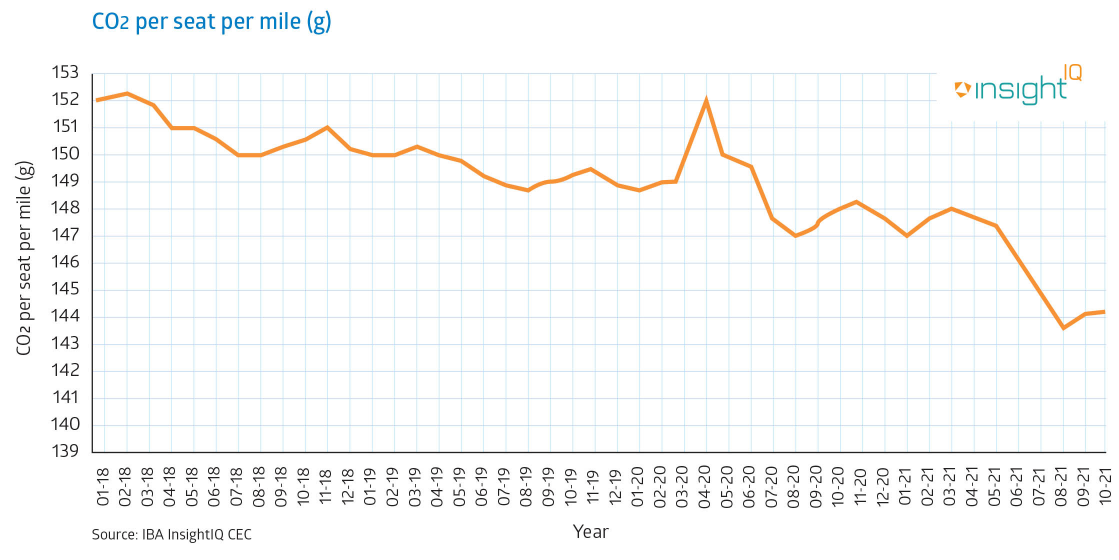
Built on data points from the beginning of 2018, the IBA aviation Carbon Emissions Index continues to showcase the aviation industry's efforts in driving efficiency in their fleets. IBA observes an overall reduction of 5.2% on a rolling three-month basis over the past 4 years. The efficiency improvements have been fairly linear over the last four years, with the exception of a spike at the start of the pandemic (Q2-2020) when airlines based in the Middle East region remained active while many other carriers suspended operations. These were predominantly flying the Boeing 777-300ER.
A 2.8% drop in the index has been registered between March and August 2021. This is primarily driven by over 540 new technology aircraft being delivered during that period. In October 2021, global emissions resided at 144.2 grams of CO2 per-seat per mile. Despite the slight increase observed by the IBA aviation Carbon index in the past few months, we still expect the overall downward trend going forward as airlines and lessors continue their fleet renewal schemes and introduce more fuel-efficient assets.
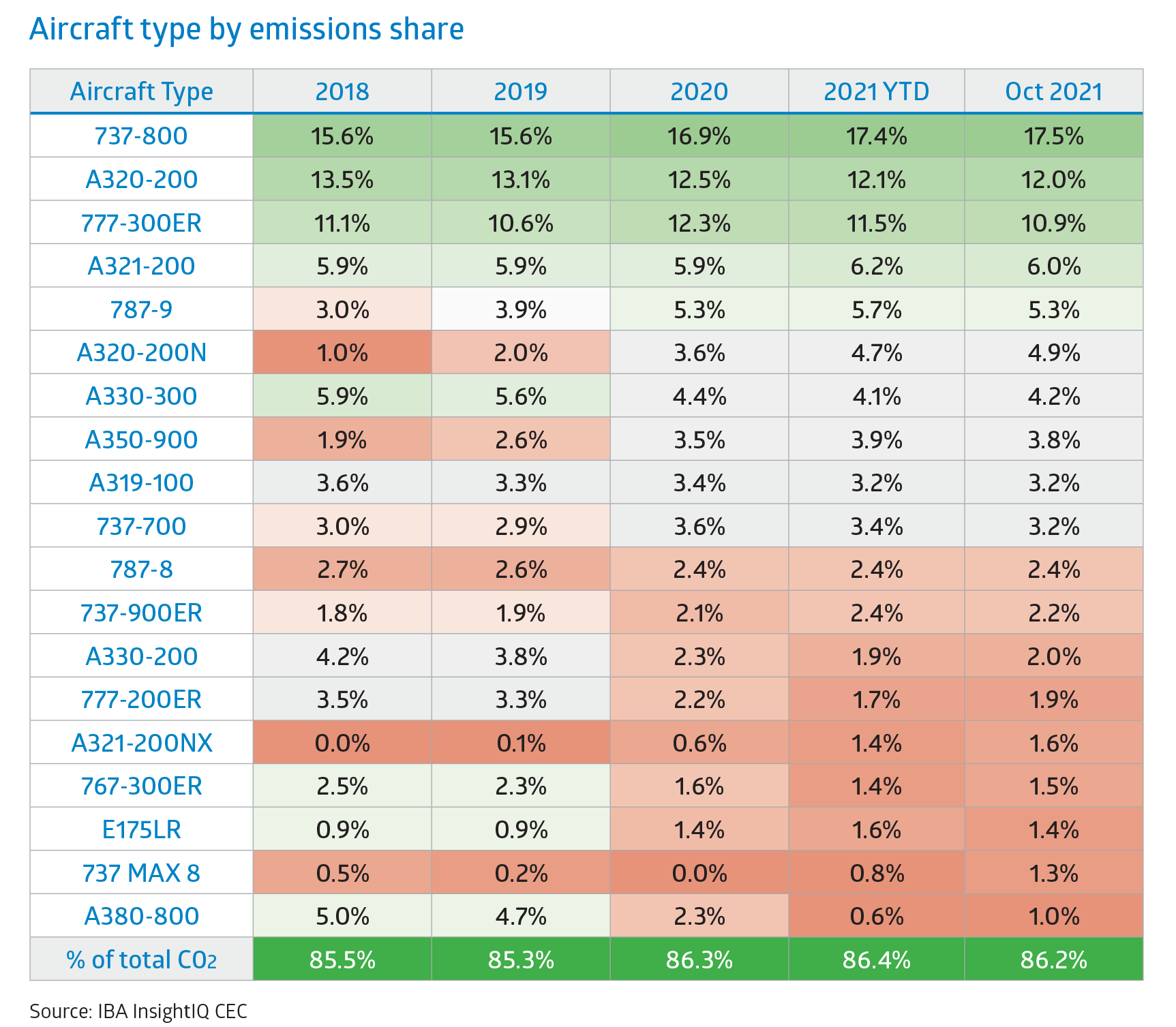
The Boeing 737-800 aircraft remains the single highest contributing aircraft. Despite reduced utilization due to the pandemic, the aircraft's emission share experienced an increase of 1.3% compared to 2019. The performance of the 737-800 has remained strong into 2021, but with a smaller rise of 0.4% observed YTD. This has been impacted by the increased delivery in new technology aircraft, especially the Boeing 737 MAX, which has seen a rapid increase in deliveries since November 2020. The 737 MAX which experienced a marked increase in emissions in October 2021, topping out with a 1.3% share of emissions.
The 737NG's Airbus counterpart has seen the opposite trend, with the A320-220 registering a 1.1% drop in the same period. Widespread grounding of older A320ceo aircraft is contributing to this, with around 53% of the in-service fleet grounded. IBA expects large numbers of these aircraft to re-enter active service, but older A320ceos will continue to exit active fleets as the NEO increasingly dominates. As of October 2021, both A320-200N and A321-200NX variants were witnessing moderate increase, representing 4.9% and 1.6% emission share respectively.
The A320-200N has one of the largest gains in total CO2 emissions share in the narrowbody fleet, jumping from 1% to 4.7% of the worldwide fleet between 2018 and October 2021. It is one of the few aircraft to increase its active worldwide fleet in that period, from 484 to 1,245 examples as of October 2021. In addition, the larger variant of the NEO family, A321-200NX has joined the top 20 aircraft type in 2021 for the first time since its delivery. As of October 2021, this NEO type has grown from 103 in 2019 to 388 units in October 2021, which is nearly four times as many as the pre-Covid fleet.
The Boeing 777-300ER has retains its position as widebody type with the largest carbon emission share, largely thanks to its over 80% active fleet since 2021. The most significant change is logged by the Boeing 787-9, partly due to a 40% increase in fleet size, but also because a large portion of the fleet has remained active throughout the pandemic. These have filled the void left by legacy aircraft such as the 777-200ER and 767-300ER models, which no longer require the same levels of capacity. This delivers a significant reduction in CO2 per trip and per seat mile, giving airlines some respite in costs and reduced emissions.
The biggest casualty remains the Airbus A380, falling from 5% in 2018 to 0.6% so far into 2021, which corresponds to an 80% reduction in its active fleet during that period. As of October 2021, 8 out of 14 current A380 operators have announced the retirement or early retirement of the type. IBA predicts that many in long-term storage will not re-enter service, with the only airline still operating significant numbers being Emirates.
With an early demand resurgence observed in the regional market, the number of monthly flights operated by the Embraer E175LR model has so far resumed to the pre-Covid level, accumulating 70,000+ flights in October 2021. Those regional flights are mainly concentrated in the United States, with operators such as SkyWest Airlines and Republic Airways. Due to this earlier sign of the traffic recovery within the regional segment compared to the narrowbody and widebody markets, the E175LR model has undergone over 48% increase in its emission share over the last four years, arriving at 1.6% so far in October 2021.
Out of the largest 30 lessors, the top 5 with the lowest average CO2 per seat per mile for 2021YTD are listed below.
The acquisition of GECAS by Aercap has created a 'super lessor' within the market. Their merged portfolios now represent over 2,200 aircraft with a varied blend of asset types. Prior to the acquisition, AerCap was recorded at 133g CO2 per seat per mile for 2021YTD, which has then increased to 138g CO2 per seat per mile since the merge.
Within the regional space, Nordic Aviation Capital (NAC) unsurprisingly have one of the lowest figures in terms of CO2 per mile, however they are 24.3% above the industry average on a per seat basis due to the very nature of the small cabin size assets within their portfolio.
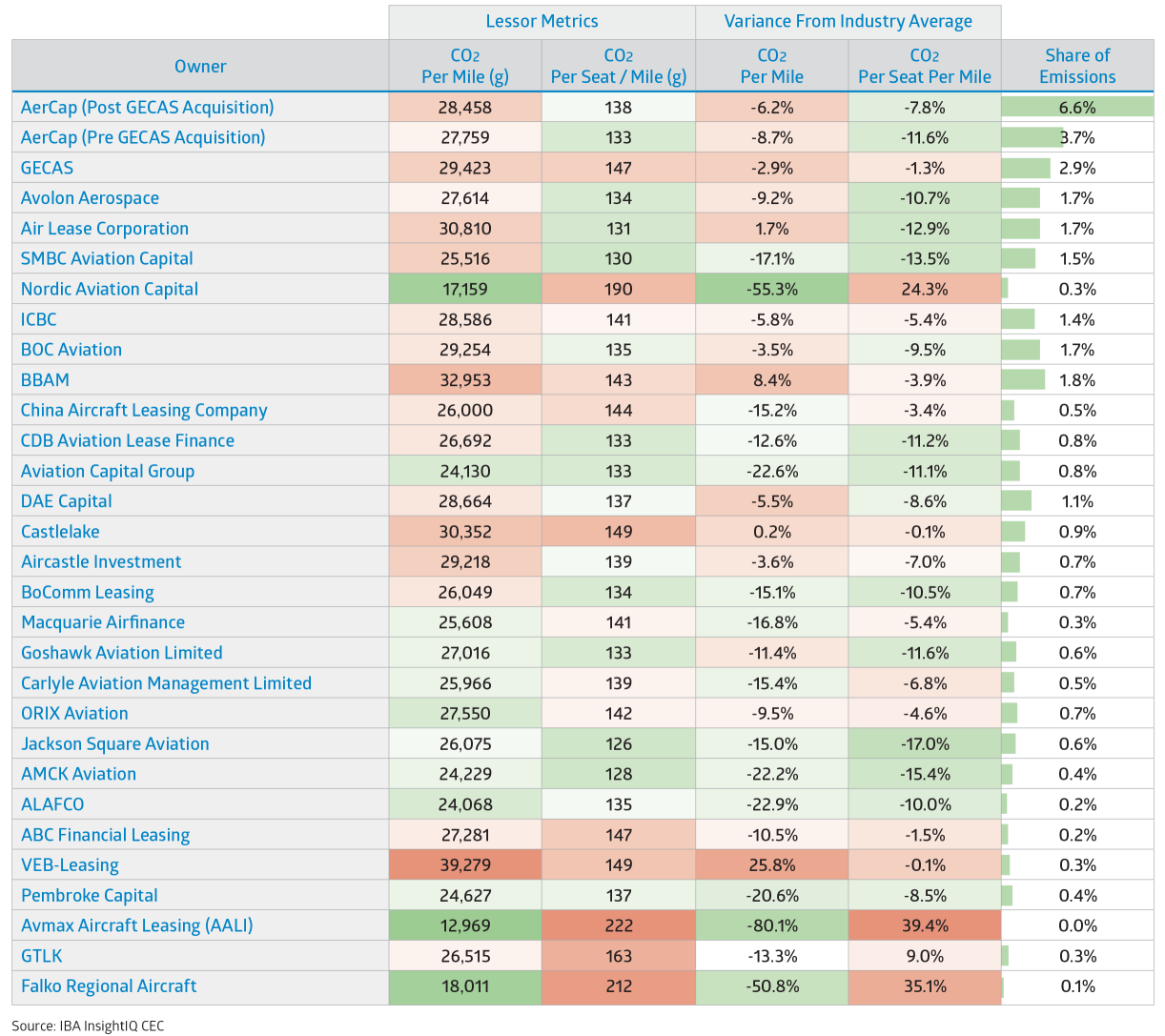
Note: This table shows the top 30 lessors in terms of total aircraft managed within their portfolios and the associated emissions metrics related to the assets operated in 2021 so far. Each lessors' performance is measured against the industry average figures for CO2 per mile (g) and CO2 per Seat / mile (g).
In this month's edition, IBA looks at airline efficiency through the lens of the Asia Pacific, Latin American and Middle Eastern regions.
5 APAC airlines lead the way in 2021. All operate a low-cost carrier model using mostly latest generation aircraft. On average, the airlines listed below have a lower CO2 per-seat per-mile compared to the 50 largest airlines operating within the region.
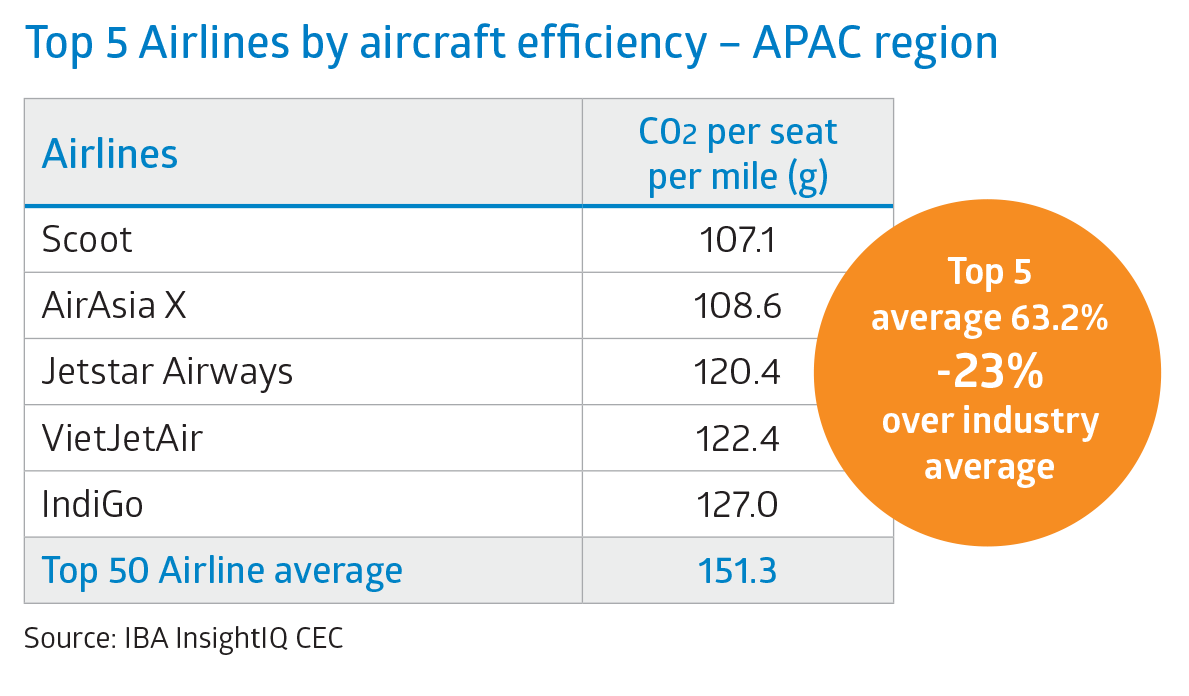
The best performing Latin American airlines operate varied business models, but again mainly utilise newer aircraft. On average, the airlines listed below are 17% more efficient per-seat per-mile when compared to the 50 largest airlines operating within the Latin America region.
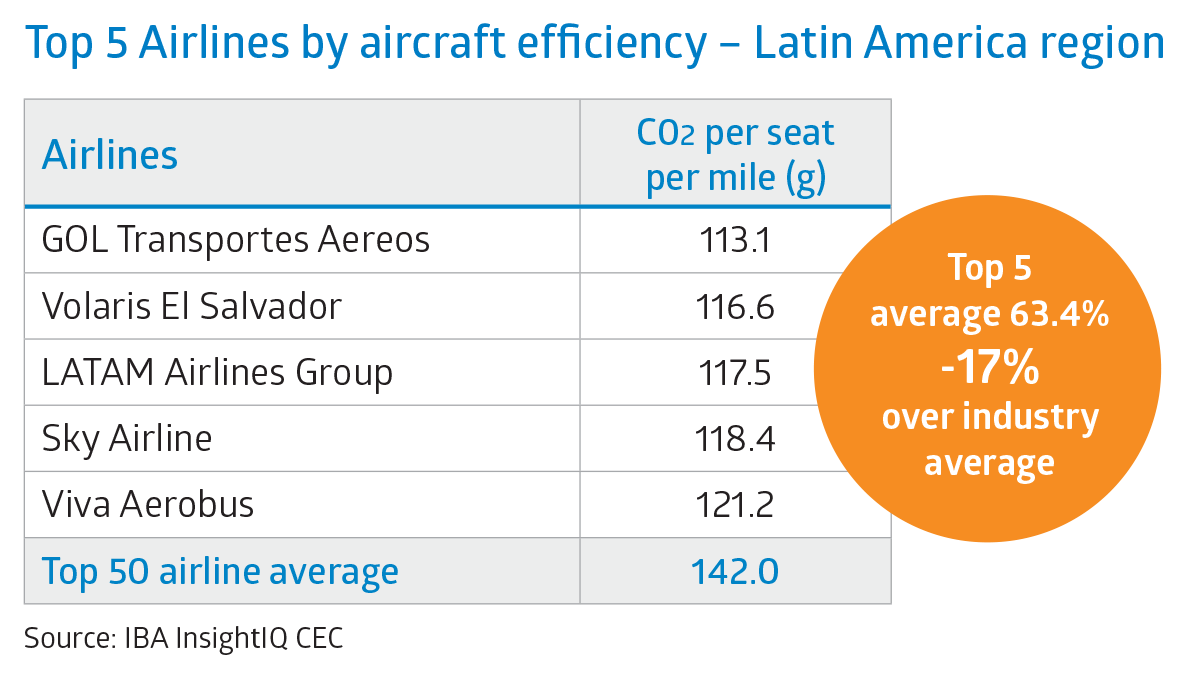
flydubai tops the efficiency league in the Middle East with 123.4 grams of CO2 per-seat per-mile. On average, the top 5 airlines are 17% more efficient by this metric than 50 largest airlines operating in the region.
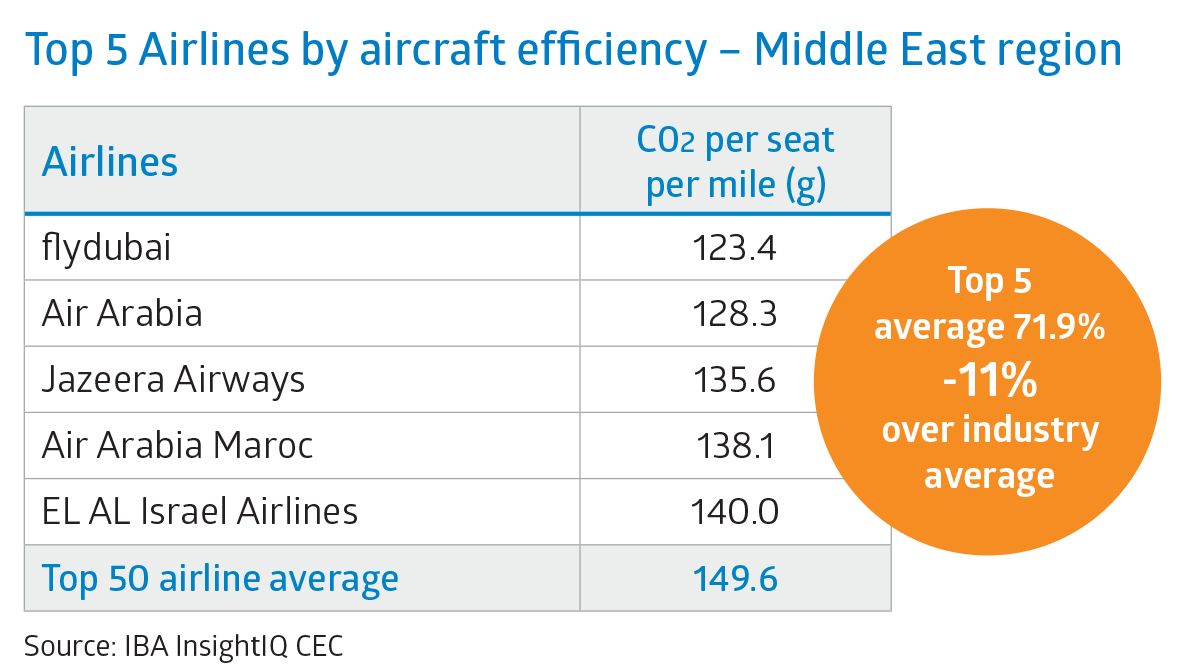
IBA's aviation Carbon Emissions Index is powered by our Carbon Emissions Calculator, part of InsightIQ.
IBA's InsightIQ analysis platform flexibly illustrates multiple asset, fleet and market positions, actual and potential, to inform client choices and identify acquisition opportunities. Immediate access to crucial aircraft, engine, lease rate and fleet data eases appreciation of historic and future aircraft concentrations and operator profiles.
関連コンテンツ
Using your queries, we have endeavoured to answer 5 top questions you had about electric aircraft.